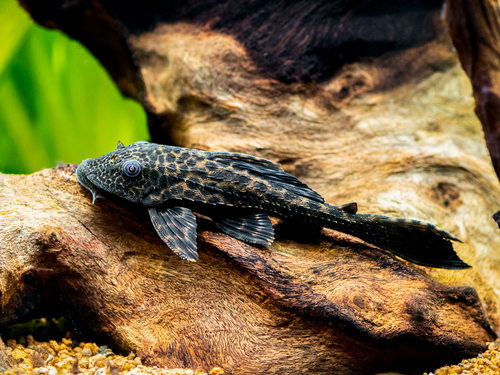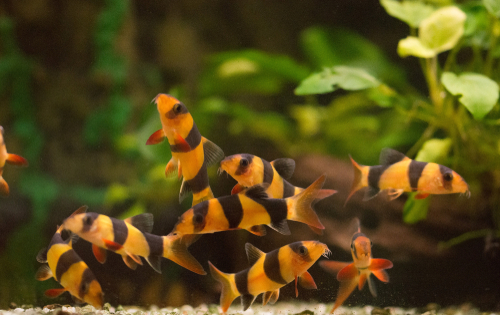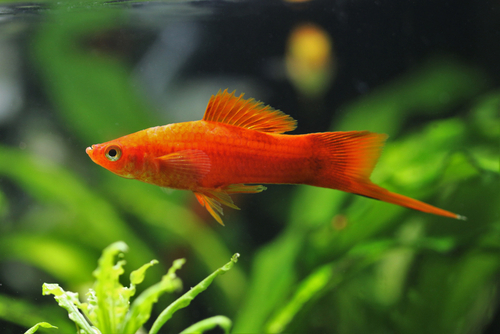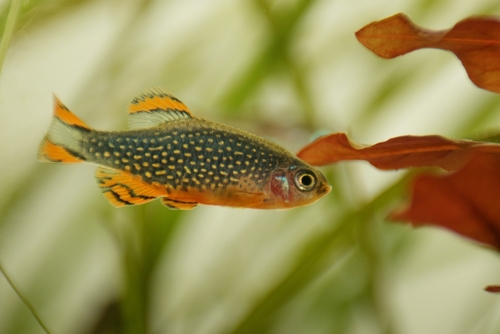It’s often tricky to pair tiger barbs with other fish. This is because Tiger Barbs, including the Green Tiger Barb, are notorious for being aggressive if there isn’t enough space in the tank. If you have fewer than six Green Tiger Barbs in a tank, they get even more aggressive. So, right away, you have a decent chunk of space taken up purely by Green Tiger Barbs.
Don’t fret, though. It’s challenging to find tank mates, but it isn’t impossible. There are several Green Tiger Barb tank mates that you can choose from, and we have ten awesome choices for you here.
Contents
Green Tiger Barb Tank Mates – What You Need to Know
Green Tiger Barbs aren’t that different from any other tiger barb. So, most info about the best Green Tiger Barb tank mates will apply to pretty much everything in the Tiger Barb family.
Before we take a deep dive into the best fish to pair up with your Green Tiger Barbs, we figured we’d take a look at the requirements for the fish. This will be information that we lean on when we discuss the best pairings.
Temperament
Green Tiger Barbs are what we would call semi-aggressive. They won’t be cruising around your tank looking for a fight. Well, they shouldn’t. But, if the green tiger barb doesn’t have lots of space, or there aren’t enough Barbs for them to school properly (need a minimum of 6) then they do get a touch aggressive. They probably won’t kill your other fish, but they may nip at their fins.
Size
Green Tiger Barbs grow to a shade under 3″. Some can grow a little larger, but they are rarer. Most will probably cap out at the 1-2″ mark. They aren’t big fish, but they need a whopping amount of space. This is a very, very active species. If they aren’t darting around the tank constantly, they aren’t happy.
Competition
Green Tiger Barbs can be bullies if they want to be. While they won’t necessarily ‘compete’ with other fish for resources, they have been known to try and keep some of the more peaceful fish away from food. Green Tiger Barbs often work best with larger, peaceful fish that they won’t be trying to bully (or other fish that aren’t afraid to stand up for themselves).
You would probably want to avoid fish with longer fins, though. Green Tiger Barbs are nippers, and we have seen them latch onto things like Angelfish with no care in the world.
Parameters & Tank Setup
For every 5 Green Tiger Barb, you should have around 20-30 gallons of space. The more, the better. Less space means more aggression.
When they aren’t swimming around, Tiger Barbs love to hide. So, pack that tank with loads of foliage, decorations, etc. It may even help them to be a touch less aggressive because they can hide away.
Water levels should have a pH between 6.0 and 8.0, and temperatures 72-82°F.
So, that’s what we will have to keep in mind as we decide on our Green Tiger Barb tank mates!
The Best Green Tiger Barb Tank Mates
All ten of these fish will be great tank mates for most types of Tiger Barb, although we have selected them based on their compatibility with the Green Tiger Barbs.
Check out these other popular posts in this category:
1. Corydoras Catfish

- Scientific Name: Corydoras
- Adult Size: 2.75″
- Compatible with: Tetras, other Corys, Swordtails
- Care Level: Very Easy
- Origin: South America
The Corydoras Catfish is a very docile fish. The Corydoras will grow to, roughly, the same size as the Green Tiger Barb so you shouldn’t run into too many issues.
The Corydoras Catfish spends most of its time bottom-feeding, and since your Tiger Barbs are going to be hanging around the middle of the tank, they probably won’t be bumping into one another too often.
While the Corydoras Catfish isn’t all that aggressive, the size does mean that your Green Tiger Barbs probably won’t be swiping food from it either. Not to mention that the skin of this is tough. If your Green Tiger Barbs do try and nibble at it, they’ll probably only do it once.
They both thrive in broadly the same environment. Corydoras Catfish love to hide in foliage just as much as your Green Tiger Barbs do.
While the Corydoras Catfish can survive living on its own, we recommend that you get a couple of them.
Pros of keeping with Green Tiger Barb
- No aggression towards Green Tiger Barbs
- Enjoys the same tank conditions as the Green Tiger Barbs
- Peaceful bottom feeders
Cons of keeping with Green Tiger Barb
- Green Tiger Barbs could grab food before it hits the feeding area of the Catfish
- Need a deep substrate, which can take up a good amount of space.
2. Cherry Barb

- Scientific Name: Puntius titteya
- Adult Size: Up to 2″
- Compatible with: Platy, Celestial Pearl, Tetras
- Care Level: Very Easy
- Origin: Sri Lanka
Outside of their size and color, there aren’t many differences between the Cherry Barb and the Green Tiger Barb. They both love to school (minimum of 6), and they are peaceful creatures unless they feel under threat.
Cherry Barbs are slightly smaller than the Green Tiger Barb, but this doesn’t really seem to be a major issue when you pair them up in a tank. This is because, hopefully, you’ll be purchasing a minimum of 6 Cherry Barbs for your tank. Since they will school, the Green Tiger Barb is going to think twice about bullying them.
These are very, very shy creatures anywhere. Chances are they probably won’t be spending too much time anywhere near the Green Tiger Barb anyway. In fact, while the Cherry Barb is a fish that normally hangs around the middle of the tank, it isn’t uncommon for them to swim down to the bottom and live there if they feel it is a bit too ‘risky’ to swim further up.
Just like the Green Tiger Barb, the Cherry Barb loves a tank that is crowded with decorations, etc. They enjoy having hiding spaces.
This is the perfect addition for any tank, even if you only ever have Green Tiger Barb swimming around there. The colors complement each other well.
Pros of keeping with Green Tiger Barb
- Get on well with Green Tiger Barbs
- Beautiful colors complement the Green Tiger Barbs well
- Won’t attack each other
Cons of keeping with Green Tiger Barb
- Very shy and prone to hiding.
- If you have less than 6, they could get bullied by the Green Tiger Barbs.
3. Pleco (Suckermouth Catfish)

- Scientific Name: Hypostomus plecostomus
- Adult Size: 15″
- Compatible with: Corys, Tetras, Guppies
- Care Level: Easy
- Origin: Brazil, Trinidad & Tobago
If you are after a larger catfish, then the Pleco could be one of the best Green Tiger Barb tank mates. Although, do bear in mind that you’ll need a rather hefty amount of space for these catfish to swim about in. The Pleco needs at least 75 gallons of space to thrive. Although, this should be enough space for you to pair 10-12 Green Tiger Barbs with them.
The patterns on the Pleco are absolutely gorgeous, and they can add a touch of visual appeal to just about any aquarium. Considering their size, they are highly active too. You’ll always see them swimming near the base of the tank. They love to slide in and out of the foliage.
While we doubt that your Green Tiger Barbs will bother coming close to the Pleco, you’ll be pleased to know that if they did try, they won’t succeed. This is an armored catfish. They are tough as nails. Barely anything in your tank will touch them.
Pros of keeping with Green Tiger Barb
- Very docile
- Too large for your Green Tiger Barbs to bully
Cons of keeping with Green Tiger Barb
- Minimum of a 75-gallon tank
- They eat a lot
4. Clown Loach

- Scientific Name: Chromobotia macracanthus
- Adult Size: 8″ (in captivity)
- Compatible with: Tetras, Barbs, Danios, Angelfish
- Care Level: Medium to Easy
- Origin: Indonesia
If you are after a stunningly beautiful fish to pair with your Green Tiger Barb, then the Clown Loach may be perfect. This Indonesian freshwater fish boasts a beautiful orange/black stripe pattern. They are incredibly docile and social animals too, so they will not bother your Barbs.
These do grow up to 8″ in captivity (12″ in the wild), and they are schooling fish. You’ll need a minimum of 6 of them, and this means that they will require a tank of 75 gallons or larger.
Luckily, these tend to swim closer to the bottom than your Green Tiger Barbs, so they shouldn’t be competing for resources too much. You’ll need a decent amount of food in the tank, though. Make sure you feed plenty wafers or pellets that will sink down to the bottom for them.
Obviously, the large size means that your Barbs won’t want to come anywhere close to them, so no need to be concerned about bullying. The problem with the Clown Loach is that they are a bit trickier to keep than the Green Tiger Barbs.
The Clown Loach is not really a fish that does well in captivity (they rarely breed in captivity), and they desire almost perfect water conditions. Any contaminants need to be filtered out quickly. So, we wouldn’t recommend the Clown Loach unless you’re an experienced fishkeeper.
Pros of keeping with Green Tiger Barb
- Large fish, won’t bother your Barbs
- Beautiful to look at
- Bottom feeders that can mop up what the Barbs don’t eat
Cons of keeping with Green Tiger Barb
- Requires a larger tank
- Requires almost constant water testing
5. Rosy Barb

- Scientific Name: Pethia conchonius
- Adult Size: 6″
- Compatible with: Cherry Barb, Tiger Barb, Tetra
- Care Level: Easy
- Origin: Southern Asia, mostly Afghanistan
The Rosy Barb is the largest fish in the Barb family, and it pairs up with the Green Tiger Barb incredibly well. It boasts a beautiful orange color, which only gets brighter during the mating season.
In some cases, the Rosy Barb has been known to bully other smaller fish, although this rarely happens to the Green Tiger Barb. If anything, the Rosy Barb is much more likely to spend time schooling with the Green Tiger Barb than it is to bully it.
The Rosy Barb will act as a protector, of sorts. Although we probably wouldn’t pair the Rosy Barb up with too many smaller fish, the Rosy Barb could nip their fins (the Tetra is really an exception to this).
As these are Barbs, they have broadly the same diet as the Green Tiger Barb. They are omnivorous. Although, do make sure that your fish are getting an equal amount of food. Because of the larger size of the Rosy Barb, there is a chance that they could munch on the food before your Green Tiger Barb gets there.
Remember, the Rosy Barb will need a minimum of 6 at a time, just like the Green Tiger Barb.
Pros of keeping with Green Tiger Barb
- Will sometimes school with the Green Tiger Barb
- Similar diets to Green Tiger Barb
Cons of keeping with Green Tiger Barb
- May ‘steal’ food from Green Tiger Barb
- Can nip the fins of smaller fish.
6. Swordtails

- Scientific Name: Xiphophorus hellerii
- Adult Size: 6.3 inches
- Compatible with: Tetras, Corys, Mollies, Guppies
- Care Level: Medium to easy
- Origin: Mexico, Guatemala, Belize, and Honduras
Normally, we wouldn’t recommend something that has a tail the length of the Swordtail. Although, it isn’t really an issue due to the size of the Swordtail. While you may find that the odd Green Tiger Barb may nip at the ‘sword’ on the swordtail, it doesn’t happen too often. Most of them won’t even venture close to a fish of this size.
The swordtail is a stunning fish to look at, and it is awe-inspiring to see the beautiful, ‘sword’ bobbing and weaving between dense vegetation in the tank. The Swordtails work incredibly well when in groups of four. They tend to stick around the base of the tank, so they won’t really be bothering your Green Tiger Barbs.
They do share a very similar diet to the Barbs (omnivorous), so you can use the same pellets/feed, between the two of them. The Swordtails can feed from most sections of the tank, but they’ll probably bottom feed instead, again keeping clear of the Barbs.
The downside is that these are a bit trickier to look after. Nothing that a fish keeper with a small amount of experience under their belt wouldn’t be able to handle.
These fish, while hardy, have a much narrower pH level spectrum to aim for (7.0 to 8.3) than the Green Tiger Barbs, so you’ll have to pay much more attention to the water quality. If you can handle that, then these fish can deal with pretty much anything, even a nip or two from the Barbs.
Pros of keeping with Green Tiger Barb
- Barbs won’t really pay attention to them
- Similar diet
- Both enjoy dense vegetation
Cons of keeping with Green Tiger Barb
- Long tail, so some angry Barbs may nip at it.
7. Zebra Danios

- Scientific Name: Danio rerio
- Adult Size: 1.5″
- Compatible with: Catfish, guppies, platys, mollies, swordtails
- Care Level: Easy
- Origin: South Asia (possibly India and Bangladesh, but then spread throughout the continent)
At just half the size of the Green Tiger Barb, you wouldn’t think that the Zebra Danios would pair up well with them. We already told you that the Green Tiger Barb does bully smaller fish, and maybe even act a touch aggressive toward them.
Although, this doesn’t really happen with the Zebra Danios. They seem to co-exist fairly well, and this is what helps to make them one of the best Green Tiger Barb tank mates.
Part of the reason why the Zebra Danios and the Green Tiger Barb get on so well is that the Zebra Danios, while having roughly the same diet as the Barb, don’t really eat that much. This means that they won’t be competing for resources with the Green Tiger Barb. Most Barbs only bully if they feel that another fish is impacting their food supply.
The Zebra Danio, like the Barb, is a very social creature. They work well in groups of 6 or more. They are exciting to watch too, since the schools tend to establish a hierarchy, and it is amazing to watch the social group zip around the tank.
Pros of keeping with Green Tiger Barb
- Doesn’t compete with the Green Tiger Barb
- Loves lush vegetation
Cons of keeping with Green Tiger Barb
- May be bullied by some aggressive Barbs
8. Tinfoil Barb

- Scientific Name: Barbonymus schwanenfeldii
- Adult Size: 14″
- Compatible with: Cichlids, Catfish
- Care Level: Easy
- Origin: Thailand & Malaysia, but spread throughout East Asia.
Tinfoil Barbs are a beautiful silver color, and they are the largest of the Barbs. Growing to a whopping 14″, they need a ton of space to let loose, especially since they are social fish and you’ll need to buy a couple of them. This is just as well for your Green Tiger Barbs, though. They also love a huge amount of space.
For the most part, the Tinfoil Barbs are considerably more peaceful than the Green Tiger Barbs, although there isn’t really much that would bother bullying them anyway. While they do eat the same sort of food as the Green Tiger Barbs, they aren’t going to hog it or stop the Green Tiger Barbs feasting, which is a massive plus.
The only real downside is that you will need a hefty tank. A minimum of 75 gallons is required but the larger, the better. With a large enough tank, the Tinfoil Barbs can live in perfect harmony with the Green Tiger Barbs.
Pros of keeping with Green Tiger Barb
- Tiger barbs won’t bully them
- Won’t hog food
Cons of keeping with Green Tiger Barb
- Requires a very large tank
9. Celestial Pearl

- Scientific Name: Danio margaritatus
- Adult Size: Under 1″
- Compatible with: Barbs, Tetras, and other non-aggressive freshwater fish.
- Care Level: Easy
- Origin: Myanmar
The Celestial Pearl is a beautiful, speckled silver fish. It is incredibly small, and you can easily fit dozens of them in a small tank. Although, since you are pairing these with a Green Tiger Barb, you’ll still need ample space for those.
The Celestial Pearl is tiny, but Green Tiger Barbs don’t really pay much attention to it. They may chase them every so often, but there isn’t really that much aggression. Since the Celestial Pearl doesn’t really eat much, they won’t be competing for food either.
The big issue with the Celestial Pearl is that they are very shy and timid fish. If you pair them with anything much larger than the Green Tiger Barb, you will often find them hiding around in the vegetation and they will rarely come out. So, we think that having a tank with Green Tiger Barbs and Celestial Pearls is fine.
Pros of keeping with Green Tiger Barb
- Won’t eat the Green Tiger Barbs food.
- Love vegetation
Cons of keeping with Green Tiger Barb
- Some more aggressive fish may chase them.
10. Red Tail Shark

- Scientific Name: Epalzeorhynchos bicolor
- Adult Size: 4-6″
- Compatible with: Barbs, Tetras
- Care Level: Medium to hard
- Origin: Thailand
They may be critically endangered outside of captivity, the Red Tail Shark has become a firm favorite among fish keepers. Its beautiful long black body and bright red tail can certainly look stunning swimming around freshwater tanks.
We are putting the Red Tail Shark at the bottom of this list because it is an aggressive fish. It has been known to attack anything that competes with it for resources or decides to try and muscle in on its territory. So, we wouldn’t really recommend it with most fish.
The Red Tail Shark doesn’t really compete with the resources that a Green Tiger Barb needs, so you shouldn’t have too many issues. However, we do recommend a minimum of 40 gallons of space in your tank if you are pairing these up with a small group of Green Tiger Barbs.
We also recommend that you pack your tank out with vegetation. Not only will the Red Tail Sharks love it, but it gives your Green Tiger Barbs somewhere to hide on the off-chance that the Red Tail Shark decides to be a touch aggressive.
Pros of keeping with Green Tiger Barb
- Doesn’t compete with the Green Tiger Barb
- Rarely bothers the Green Tiger Barb
- Can live alone, or in groups of 2.
Cons of keeping with Green Tiger Barb
- Requires more space
- Can have an aggressive streak
Summary
Finding a Green Tiger Barb tank mate can be tricky, but not impossible. Any of the ten we have listed here would be a tremendous place to start.
As long as you choose a relatively docile fish, preferably larger than the Green Tail Barb, then you shouldn’t run into too many issues. If the tank requirements are broadly similar, you’ll be fine.
FAQs
Are Green Tiger Barbs Aggressive?
They can have an aggressive streak, but only if they are competing for resources. Most of the time, they are very peaceful fish.
How Many Green Tiger Barbs Can You Have in One Tank?
You should have a minimum of 20 gallons of space per 6 Green Tiger Barb. They love to swim around a lot.
What Is The Best Tank Mate For a Green Tiger Barb?
The Corydoras Catfish is the best tank mate for a Green Tiger Barb. Not only does it look good, it won’t bring out the aggressive streak that some Barbs have.

JJ has had a passion for learning about aquatic life since age 5. As an adult, he made his passion a career as a certified aquaculture dealer and aquarium content creator.


